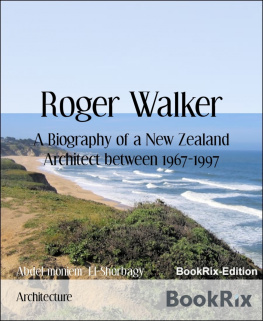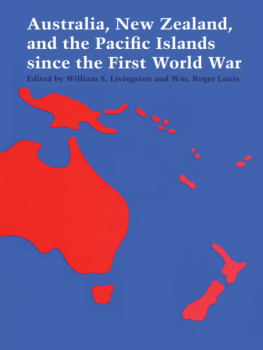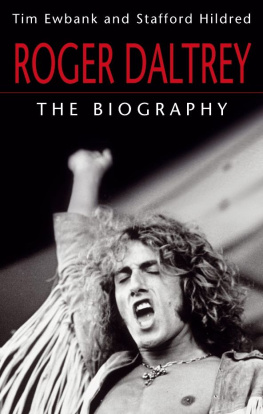Abdel-moniem El-shorbagy - Roger Walker: A Biography of a New Zealand Architect between 1967-1997
Here you can read online Abdel-moniem El-shorbagy - Roger Walker: A Biography of a New Zealand Architect between 1967-1997 full text of the book (entire story) in english for free. Download pdf and epub, get meaning, cover and reviews about this ebook. year: 2020, genre: Detective and thriller. Description of the work, (preface) as well as reviews are available. Best literature library LitArk.com created for fans of good reading and offers a wide selection of genres:
Romance novel
Science fiction
Adventure
Detective
Science
History
Home and family
Prose
Art
Politics
Computer
Non-fiction
Religion
Business
Children
Humor
Choose a favorite category and find really read worthwhile books. Enjoy immersion in the world of imagination, feel the emotions of the characters or learn something new for yourself, make an fascinating discovery.
- Book:Roger Walker: A Biography of a New Zealand Architect between 1967-1997
- Author:
- Genre:
- Year:2020
- Rating:3 / 5
- Favourites:Add to favourites
- Your mark:
- 60
- 1
- 2
- 3
- 4
- 5
Roger Walker: A Biography of a New Zealand Architect between 1967-1997: summary, description and annotation
We offer to read an annotation, description, summary or preface (depends on what the author of the book "Roger Walker: A Biography of a New Zealand Architect between 1967-1997" wrote himself). If you haven't found the necessary information about the book — write in the comments, we will try to find it.
Roger Walker: A Biography of a New Zealand Architect between 1967-1997 — read online for free the complete book (whole text) full work
Below is the text of the book, divided by pages. System saving the place of the last page read, allows you to conveniently read the book "Roger Walker: A Biography of a New Zealand Architect between 1967-1997" online for free, without having to search again every time where you left off. Put a bookmark, and you can go to the page where you finished reading at any time.
Font size:
Interval:
Bookmark:

BookRix GmbH & Co. KG
80331 Munich
Roger Walker
A Biography of a New Zealand Architect between 1967-1997
Acknowledgments
Introduction
Chapter 1 Early Life
Chapter 2 Late Life and Career
Conclusion
Appendix 1 Chronological List of Walkers Buildings
Appendix 2 Awards and Competitions
Bibliography
I am enormously indebted to my wife for her enthusiastic support, helpful comments and effective criticism. The kindness of my wife and family made it possible for me to write this book.
The New Zealand architect Roger Walker (b.1942) is one of the few architects who has created a new style which has affected the establishment and evolution of a New Zealand architectural identity. Walker was born when modern movement architecture started to appear in New Zealand, he studied architecture when modern architecture reached maturity and the theories of post-modern architecture were being formulated, and he began to practice as post-modernism began its initial development. During his growing practice Roger Walker has significantly developed his personal architectural style and has contributed to an emerging concept of regional architecture and strengthened the notion of New Zealand architectural identity. Roger Neville Walker was born in Hamilton, New Zealand in 21 December, 1942. His father, Andrew Frank Walker, was a chemist and his mother Margaret (ne Clothier) was a doctors receptionist. Roger Walker is the eldest of three children, having one sister and one brother. His brother Gavin still lives in Hamilton and is a builder specialising in roofing contracts. His sister, Sandra, is a book-shop manager in Auckland. Walker himself has been twice married. From his first marriage, which was dissolved in 1984, he has two sons and one daughter; Emily Susan is 27 years old and working as a television broadcaster in Sydney; Jacob Llewellyn is 25 years old and working as an artist, and Edward is 23 years old and working as an art director in films. In 1986 Walker married Elizabeth Street, and they have one son, Maxwell, who is 10 years old.
Early Life and Career
Walkers early life was little different from that of thousands of other New Zealand children born in the 1940s. He grew up in quarter acre suburban section in Hamilton in a single storey brick and tile, builder-designed house with a large front lawn and a straight concrete path to the front doorway. This conventional environment formed the backdrop to the upbringing of the younger Roger Walker, a backdrop which was to become a powerful motivating factor in his development. The strongest impression made by this early environment was its disagreeable and disappointing qualities, its flatness and absence of surprise. Roger Walkers picture-books told him about castles, secret passages, spiral staircases and hidden corners. But in the real world he was confronted by a depressing landscape and homes with meaningless forms and boring shapes. Walker preferred his colourful books that enlightened him and increased his knowledge about forms, colours and materials.
Walkers parents enthusiastically provided him with every opportunity to develop and extend his own identity and individuality. However, the child Roger disliked all forms of sport and therefore filled his spare time playing with meccano, building trolleys and even wooden carts to go down the local hills. He also built huts and assembled model aircraft using balsa wood, paper and glue. There were a lot of opportunities for playing, especially in the wonderfully verdant gully with its difficult topography near his home. This was later filled in to become a school playground. This destructive act deeply impressed Walker and he has always seen the flat site as the most difficult one on which to create a house. After the school buildings were finished Walker was offered left over building materials which he used to build his first fantasy Gothic castle, Fort Nyte. Constructed with the assistance of his brother and friends, it was armed with a catapult on the top but neighbours felt their privacy was endangered. As a result, the local authority gave Fort Nyte two weeks notice to be demolished because it had been built without a permit, and consequently the ten years old Roger returned to his trolleys and aircraft. This was to be the first of many occasions in which Walkers buildings contravened local building codes. Walker still vividly remembers the neighbours as materialists who well understood the value of the BMW parked self-consciously on the front drive, but were singularly devoid of a human idea.
As a child Roger Walker travelled around the country with his father, trout fishing and climbing mountains and hills. He also enjoyed staying with his brother and sister at the beach. All these experiences gave him a deep love for and appreciation of the physical and varied landscape of New Zealand. At Hamilton Boys High School, which he attended from 1955 to 1960, he studied English, art and mathematics but felt that he could not express himself through these subjects because what he really wanted to become was a car designer. Walker was particularly interested in the design of racing cars. He read a lot of car magazines, while his drawings and paintings of futuristic cars awakened a remarkable interest in art. But the metal and wood workshops attracted him more than merely drawing or painting pictures. At high school, Roger Walker knew little about architecture and he was not able to distinguish between architects buildings and those of other designers, because all of these buildings seemed to be the same. Walker was told about architecture by the vocational guidance officer during his School Certificate fifth form year. Roger concentrated on getting a scholarship to finance his university study and, with great enthusiasm, decided to become an architect in order to create buildings that would give pleasure to those who used them.
In 1961 Walker began to study at the University of Auckland School of Architecture. Moving from Hamilton to Auckland was a great change in his life and environment. Walker enjoyed Auckland as a cosmopolitan city which contrasted with Hamiltons one-dimensional, middle-class character, but he was also confronted with many things that
were not found in Hamilton such as old houses, poor people, immigrants and especially restaurants. These he described as, something we never used. It was somehow considered unseemly not to be able to cook your own meal!. For two years Roger Walker lived at Trinity College, a combined student hostel and theological training college run by the Methodist Church of New Zealand in Grafton Road. Most of the residents were young men training to become Methodist ministers but he enjoyed the new experience of living with people who believed in something.
By the early 1960s the political scene in New Zealand was dominated by the National Government which articulated the concern for stability, prosperity and comfort which pervaded New Zealand society. The wide-spread of media linked New Zealand to the global village and created a remarkable social awakening. However, New Zealand was experiencing a period of considerable wealth and there were remarkable changes and progress in the arts, literature, music and education systems. The urban landscape was also changing especially in the main centres and large scale office blocks were starting to dominate the city skyline. Architects were responding to an influx of overseas movements such as the post-Corbusian phase of Modernism and the works of individual architects such as Kenzo Tange. But for almost the first time, while Walker was studying at the School of Architecture, the students accepted and were inspired by the work of New Zealand architects rather than simply looking to overseas architects as a reference point.
Font size:
Interval:
Bookmark:
Similar books «Roger Walker: A Biography of a New Zealand Architect between 1967-1997»
Look at similar books to Roger Walker: A Biography of a New Zealand Architect between 1967-1997. We have selected literature similar in name and meaning in the hope of providing readers with more options to find new, interesting, not yet read works.
Discussion, reviews of the book Roger Walker: A Biography of a New Zealand Architect between 1967-1997 and just readers' own opinions. Leave your comments, write what you think about the work, its meaning or the main characters. Specify what exactly you liked and what you didn't like, and why you think so.








